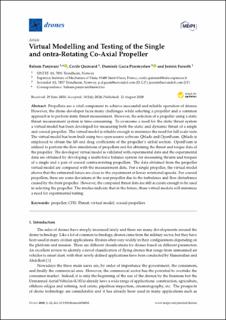| dc.contributor.author | Panjwani, Balram | |
| dc.contributor.author | Quinsard, Cecile | |
| dc.contributor.author | Przemysław, Dominik Gacia | |
| dc.contributor.author | Furseth, Jostein | |
| dc.date.accessioned | 2021-08-19T11:35:37Z | |
| dc.date.available | 2021-08-19T11:35:37Z | |
| dc.date.created | 2021-03-21T19:55:22Z | |
| dc.date.issued | 2020 | |
| dc.identifier.citation | Drones. 2020, 4 (3), 1-17. | en_US |
| dc.identifier.issn | 2504-446X | |
| dc.identifier.uri | https://hdl.handle.net/11250/2770290 | |
| dc.description.abstract | Propellers are a vital component to achieve successful and reliable operation of drones. However, the drone developer faces many challenges while selecting a propeller and a common approach is to perform static thrust measurement. However, the selection of a propeller using a static thrust measurement system is time-consuming. To overcome a need for the static thrust system a virtual model has been developed for measuring both the static and dynamic thrust of a single and coaxial propeller. The virtual model is reliable enough to minimize the need for full-scale tests. The virtual model has been built using two open-source software Qblade and OpenFoam. Qblade is employed to obtain the lift and drag coefficients of the propeller’s airfoil section. OpenFoam is utilized to perform the flow simulations of propellers and for obtaining the thrust and torque data of the propeller. The developed virtual model is validated with experimental data and the experimental data are obtained by developing a multi-force balance system for measuring thrusts and torques of a single and a pair of coaxial contra-rotating propellers. The data obtained from the propeller virtual model are compared with the measurement data. For a single propeller, the virtual model shows that the estimated forces are close to the experiment at lower rotational speeds. For coaxial propellers, there are some deviations at the rear propeller due to the turbulence and flow disturbance caused by the front propeller. However, the computed thrust data are still accurate enough to be used in selecting the propeller. The studies indicate that in the future, these virtual models will minimize a need for experimental testing. | en_US |
| dc.language.iso | eng | en_US |
| dc.publisher | MDPI | en_US |
| dc.rights | Navngivelse 4.0 Internasjonal | * |
| dc.rights.uri | http://creativecommons.org/licenses/by/4.0/deed.no | * |
| dc.subject | coaxial propellers | en_US |
| dc.subject | virtual model; | en_US |
| dc.subject | Thrust; | en_US |
| dc.subject | CFD; | en_US |
| dc.subject | propeller; | en_US |
| dc.title | Virtual modelling and testing of the single and ontra-rotating co-axial propeller | en_US |
| dc.type | Peer reviewed | en_US |
| dc.type | Journal article | en_US |
| dc.description.version | publishedVersion | en_US |
| dc.rights.holder | © 2020 by the authors. Licensee MDPI, Basel, Switzerland. This article is an open access article distributed under the terms and conditions of the Creative Commons Attribution (CC BY) license (http://creativecommons.org/licenses/by/4.0/). | en_US |
| dc.source.pagenumber | 1-17 | en_US |
| dc.source.volume | 4 | en_US |
| dc.source.journal | Drones | en_US |
| dc.source.issue | 3 | en_US |
| dc.identifier.doi | 10.3390/drones4030042 | |
| dc.identifier.cristin | 1899714 | |
| cristin.ispublished | true | |
| cristin.fulltext | original | |
| cristin.qualitycode | 1 | |

